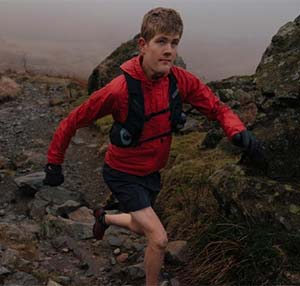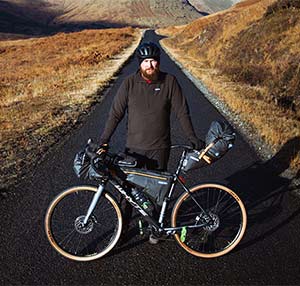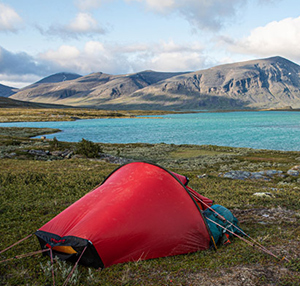The Journey: Justin Oliver Davis Q & A
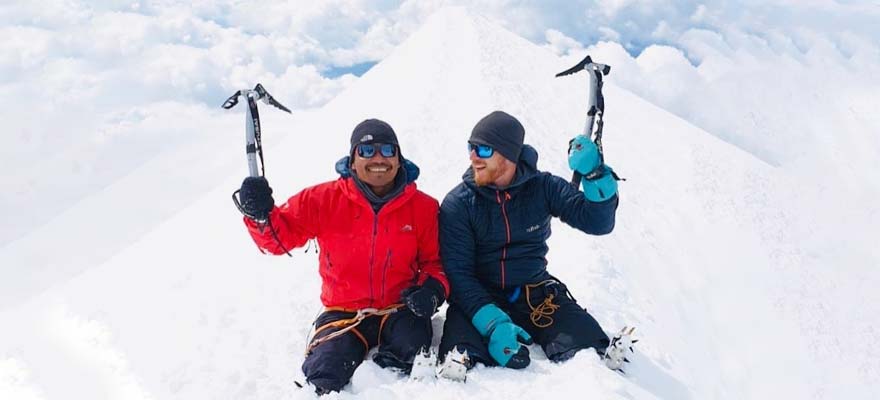
Justin Oliver Davis is a retired soldier, who suffered a horrific injury while serving his country in Afghanistan, resulting in loss of both his legs. He has overcome physiological and psychological battles to prepare himself for the challenge of climbing the highest mountain in each continent while spreading positivity and determination as he goes.
We got the chance to chat with him and learn more about the man and his journey.
Q: Hi Justin, thanks for making the time to have a chat with us. Ever since we learned about your story from our friends at Osprey we’ve been keen to meet up and share your journey with our readers.
Could you start by telling us about your life in the army, what inspired you to join the army, what was your role, some of the tours you were involved in and why you enjoyed that job?
Life in the army was fun, challenging, arduous and truly testing; both physically and mentally. There were days when we had little to do when in camp in the UK, and then periods when we didn’t sleep properly for days and weeks while preparing to deploy to Afghanistan. Training during that period was intense, exciting and exhausting.
A tour of duty in Afghanistan, and the personal test it would provide for me, was the catalyst for my entry into the military. I was a little bit frustrated in my current job as a bench joiner, and I just knew there was more for me in the world. I was hungry for adventure and adrenaline, while determined to push myself towards the challenge, and positive progression as an individual.
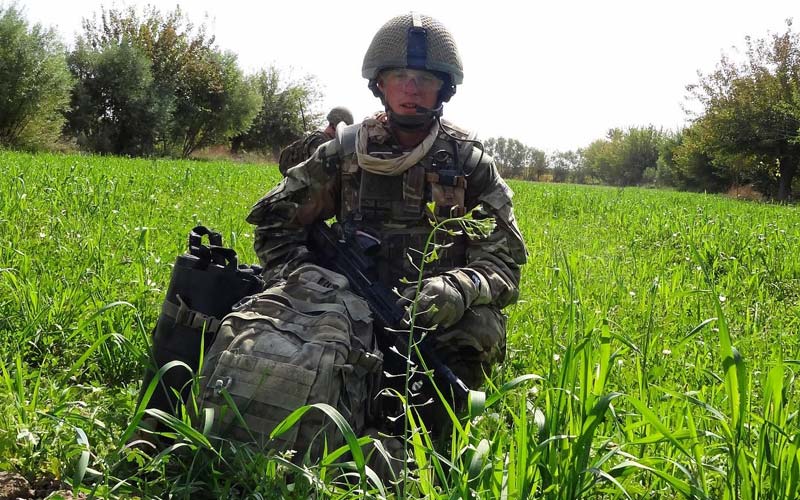
Justin in the 2nd Battalion The Rifles
I loved being around similarly-minded people with a common goal at the heart of our reasons for being together. The bonds that are created in those environments between colleagues simply cannot be replicated outside of the military environment, and I thrived while playing my part in the team. And to be honest, I felt as if I was answering my true calling to serve on operations with other motivated team members.
Q: If you don’t mind, could you explain how you came to lose both your legs and what the immediate aftermath of this situation was?
I lost my legs during an operation to intercept a Taliban ambush. We were based out of a small checkpoint in Helmand province, and on this particular day, we were acting as a QRF (Quick Reaction Force).
We were tasked at immediate notice to move to the location of a Taliban ambush. I was the point man and searching for Improvised Explosive Devices as we made our way towards the enemy positions.
Unfortunately, as we got nearer to the Taliban positions, I stood on a device with my right foot, and it was obliterated instantly. My left leg was damaged beyond repair and only hanging on with the remains of burnt skin, flesh and tendons.
The immediate aftermath was, for me, 25 minutes of laying on the floor waiting for the chinook helicopter carrying the Medical Emergency Response Team to my location. It was a horrendous experience, but I wouldn't be here if it weren't for the highly trained and skilled team around me on that particular day. During those 25 minutes, I experienced all possible emotions. It felt like an eternity, and I had no idea whether I was going to survive, and if I did, what my life would look like after sustaining such an injury.
Q: Once you had made it home and had been stabilised, your life had been turned upside down. How was your mental state, did you have a plan, how did friends and family and the army support you?
My mental state was relatively stable once I was back and safe in the UK. There were undoubtedly periods of intense suffering, pain and frustration. But, in general, I was happy and extremely fortunate to survive - and be able to speak, hear, see and use my arm(s). I say that because it took some time to get my right arm working again, as it was quite badly damaged in the explosion.
It was difficult to plan my life immediately after the injury, and I spent most of my time simply living day-to-day. Often I would be reduced to making plans only to get out of my hospital bed or to just brush my teeth by myself. There was no way of looking past my immediate environment and the restrictions I was a prisoner of, and that I had to quickly adapt to. I just wanted to heal and regain my independence, and that was only achievable by making incremental progress each day. I was missing the camaraderie and life on operations, but I had a new goal, and that was to fight back against my injuries and become active, once again.
Having family and friends around me at that time was crucial; they provided morale, support and comfort during the most challenging of times. Not to mention the countless logistical tasks. Even though I was fiercely striving towards personal independence, there were many tasks I couldn't complete without assistance. So, even if that was just passing me something I could not reach, or pushing me down the street in my wheelchair, they were there for me, and I couldn't be more grateful.
Q: We know it was a long and arduous rehabilitation process for you to recover from such a trauma for your mind and body. Can you outline some of the key events in your rehabilitation time-line, what a typical day of rehabilitation was for you and if there was a turning point where you thought ‘I’m going to be ok, I can take a new and different path in life’?
I guess the only time I experienced thoughts of being ‘Ok’ was when I had recovered to a level where I could safely leave the intensive care ward. I no longer needed life-support, and that was an enormous relief. I knew from that moment I was going to be ok, and I had to immediately start to piece my life and broken body back together, again.
The main points to note about these types of injuries are that they never leave you. They are the new constant in your daily existence. Not so much psychologically, but more noticeable physically. Every step I take when walking with prosthetics has to be thought about and planned, and that’s on flat terrain. So, when I move across undulating terrain, it not only requires further thought processing powers but a considerable amount of more energy, too.
The latest research says that a double above-knee amputee using prosthetics consumes 3x’s more energy to complete the same task as someone who is able-bodied. Life can be extremely hard as an amputee, and particularly a double amputee. The body is experiencing pain and discomfort for 90% of the time that prosthesis are in use. So, this is where my resilience is best deployed; in daily life.
Rehabilitation became a way of life, rather than a period I passed through or completed. I had to accept this as a fact that couldn’t be reversed, but it could be mitigated to some degree.
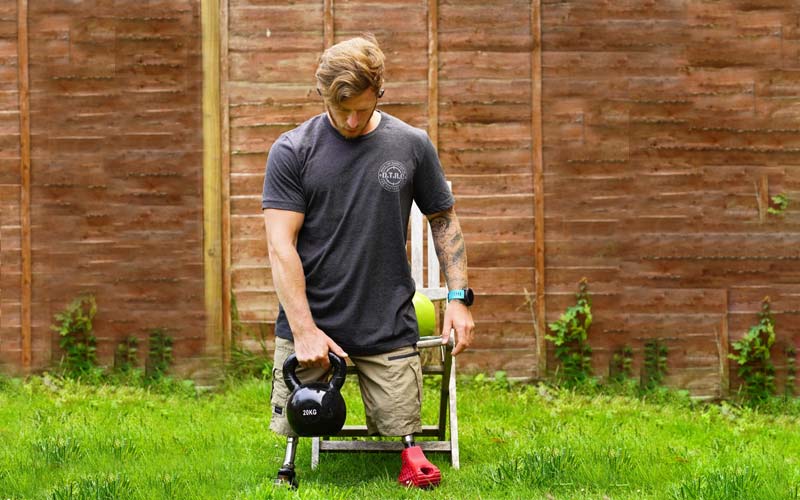
One of his many strength training workouts
I quickly realised that I would need to be physically fit and robust to navigate the previously unseen challenges my new life would present. The daily routine during the early stages of rehabilitation consisted of physiotherapy appointments, occupational therapy, lots of physical exercises, mobility classes and time to socialise and rest.
It quickly became evident that if I wanted to walk well, I had to work extremely hard, every single day. If I wanted to push myself further and climb mountains, I knew I had to be consistent for years, not just a few months.
Q: Once you got to a point where you were physically fit enough to take on challenges, what made you think you know what, I’m going to climb the highest summits in each continent?
It took me seven years to get to the point where I could physically walk far enough to even contemplate taking on any mountain. This was because my residual limbs (stumps) were not the best shape; the bone at the end was similar to the lower part of an arm with a clenched fist. The skin covering the bone at the end of my femur was thin and extremely fragile, similar to that which covers the knuckles on a clenched fist.
So, for six years, I was continually striving to reach satisfactory levels of mobility, but unable to fulfil my hopes due to multiple revision surgeries to reshape the problematic ends of my stumps. These surgeries, although minor in terms of surgical procedures, were huge distractions and appeared as almost insurmountable roadblocks in my life.
It was an extremely testing period where I had to constantly plan to fit in surgeries, recovery periods and recasting of sockets. Eventually, I got to the point where I had tried everything possible to relieve the pain I was experiencing and decided to take further action.
It was at this point where all the previous unsuccessful surgeries had culminated into the need for further, more robust action. I decided to have ten centimetres surgically removed from each of my femurs; this took me from a through-knee amputee to an above-knee amputee.
Doing so carried enormous risk and was viewed by many professionals as an unconventional and potentially hazardous procedure. One of the main reasons for this is that the surface area of bone that would now take the majority of the weight-bearing role would be significantly reduced. Alongside the reduction in size, a newly cut bone that was primed to produce painful bone spurs at any point in the future, which would result in further surgery.
However, I was certain this was the correct approach and went ahead with two individual surgeries. I had my left leg revised first, and all went to plan. Not being a fan of wheelchairs, I hopped around on crutches and one prosthetic for around six months until my wounds had healed enough for me to wear a socket and take the pressure of hopping around. I wanted to streamline this process as much as possible, but with safety and comfort at the forefront of my mind.
Once both surgeries were complete, and I had my prosthetic sockets revised a few times; I was ready to test my new stumps. I wanted something big and I was determined to push my boundaries further than they had been before.
I was just trawling through the internet looking for ‘challenges’ and I came across many cycling, rowing, swimming events, but this wasn’t what I was after, and those certainly weren’t going to test my new ‘racing’ stumps.
Mountains seemed like they would tick all the boxes for my criteria; even though they were an unknown to me. Would I even be able to move in that terrain? There was only one way to find out.
It boils down to years of being held back, years of trials, frustration, pain and true suffering. Now I was released from that horrendous period, and felt like I could take on the world! I knew I had the mindset, but I needed to prove to myself that it wasn’t just all in the head.
Q: Could you tell us a bit about your prosthetics as you have several different pairs and how they were designed to best help you achieve your goals of summits and other challenges?
The types of prosthetics vary for each individual use; for example, my ‘Long Legs’, which I wear for daily use, are made by Ottobock and provided by the British government on behalf of the British Army. I used these for a large part of the Kilimanjaro challenge as I can cover longer distances in a shorter period of time. They are best suited to terrain with minimal undulation. They are cumbersome and extremely tiring to operate at altitude, and over long distances.
The 'Crampon Feet’ I used for Mt. Blanc were designed and made by me and my Dad in his shed! We simply cut up some crampons and bolted them to plates of aluminium. These were a great first attempt at keeping the design simple yet effective.
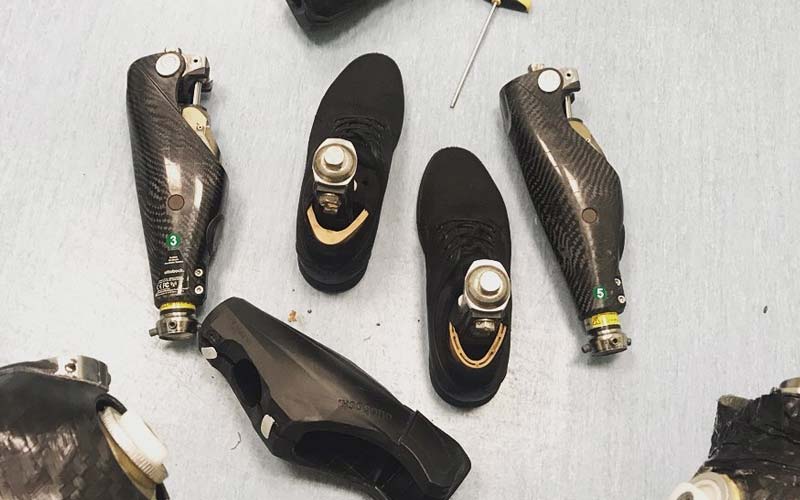
Justin's 'Long Legs'
They are robust but extremely uncomfortable to use on ice and there is no dampening of shock or impact. This significantly increases the amount of energy expended when crossing ice or rock. I now know that to be successful in the mountains, the conservation of energy is paramount, so I am currently working on improving design elements for the next set of climbing feet.
Then, I also have a set known as ‘Stubbies’; these are short in height to keep me close to the ground so I can maximise energy use and efficient movement. I basically cut up some old trail running shoes and harvested the soles to repurpose as retro-fitted grips.
These are perfect for the rocky approaches that are up to 60 degrees. I used these in and around camps and for a large part of Mt. Blanc. Slippery on ice, but great for rough surface rock, shingle and dirt.
Then I have a set of ‘Rock Climbing Feet’. These are small circular shapes of hardwood coated in the same material largely utilised in climbing shoes - they are simple and effective, great for indoor walls and crags, alike. I am also working hard, behind the scenes, to improve these ‘feet’ where I can.
Q: Your first summit was Mont Blanc, at 4,808 m above sea level.
- How did you prepare for this challenge physically and mentally?
Mentally, I was always prepared. Every day since my injury I had been preparing for this type of challenge, and having been through what I went through, instilled a belief that I had the mental capacity to push my physical body far past where it had been, previously.
My training consisted of long walks, up to 10km. Alongside regular climbing on local crags and strength training in the gym. Even though this was only around seven months after my last major surgery, I knew, in my head and heart, I had what it would take to summit.
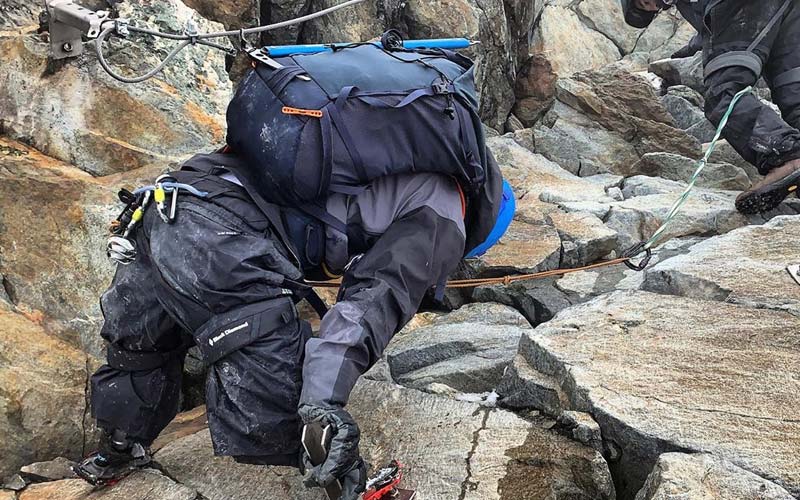
Via Ferrata training
- Who was in your team climbing with you?
The team consisted of myself, Stephan Handley (British Army veteran, and a double below-knee amputee.) And Hari Budah Magar (Another veteran of the British Army originally from Nepal. Also a double above-knee amputee.)
Guided by HST adventures which are a veteran operated company specialising in supporting us in our endeavours.
- What did you eat and drink during the climb?
We ate lots, whenever we stopped we would be snacking on high energy bars, nuts, fruit, sweets etc. Then when we arrived at strategic locations such as the Gouter hut, we would have full meals provided by the on-site chefs. We drank as much water as we could carry in the team!
- What was the hardest part?
It’s really very difficult to pick a specific part of the climb that stood out as the most challenging or hardest, but the last 100m of altitude was utterly draining. It's a combination of all variables and factors that make it so hard for an amputee to be successful in this type of endeavour. The whole climb up and down was the hardest task I have completed to date.
- How did you celebrate reaching the summit?
I cried. Tears of joy, and I cried because I had proved to myself that I was capable. After all those years of hardship, I had done it! I have goosebumps as I write this. It was so so special. It filled me with positive energy, and I wanted to refocus that into the next challenge ASAP.
- What did you learn from this first summit to take into your next climb?
Train even harder, revise and improve my climbing technique, re-design my prosthetics to enable more efficient movement and to reduce shock and impact to the body. Also, take more water, as you can never have too much!
Q: As well as setting yourself the challenge to conquer the seven summits you’ve become a keynote speaker; sharing your experience with a multitude of audiences. How was it learning to share your personal story with strangers, who do you speak to, and how do you think the audience benefits from your talks?
It was an extremely emotional experience telling my ‘story’ for the first time. I immersed myself into a week-long course held in central London where we were coached and tutored by some of the capitals most respected West-End story-tellers and directors.
It was a fantastic experience to be coached until we were able to confidently recount our individual incidents with detail and emotion. This was the first time I had revisited my incident in that kind of detail, and it was a real challenge overcoming the fear of speaking publically about it. There were tears and plenty of laughter all-round.
I have most recently spoken to military recruits, school pupils and corporate entities. I get a wonderful sense of satisfaction knowing that my largely negative experience has been transformed into something far more positive, and is now manifesting into providing a positive message and outcome to anyone who can relate to hardship, of any kind.
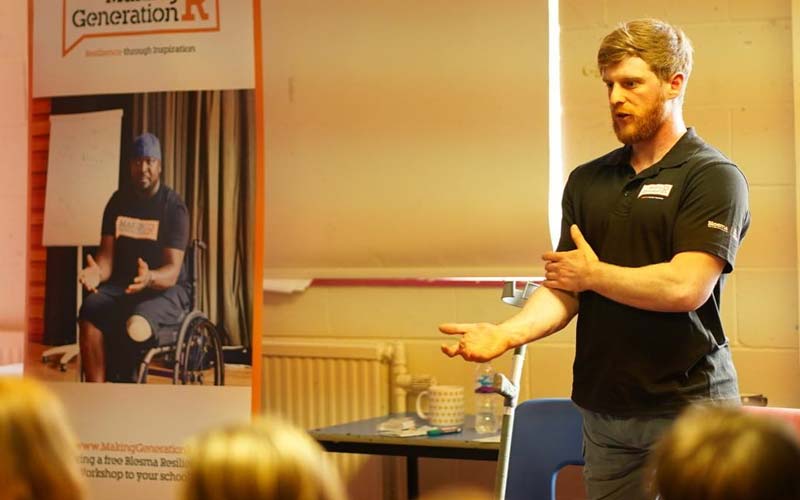
Justin speaking at a local Primary School
Whether you are a young pupil suffering from an overbearing workload or serious bullying, or a corporate employer finding it hard to motivate their staff; I always try my best to adjust my talks to suit their needs.
I believe that by me standing up on stage with both of my legs missing, and telling them my story about how I made it through, then climbed some of the world's highest mountains, is enough for anyone to relate to, and hopefully, to take something away to implement into their own lives.
Q: Your second summit was Mt Kilimanjaro which you successfully topped out in January 2020.
- How did this summit differ from mont blanc? Preparation? Prosthetics? Team? Route? Challenges?
The main difference was the distance we had to cover on the approach to the mountain. For Mt. Blanc, we practically started at the foot of the mountain, on 'Stubbies’, whereas, on Kilimanjaro, we probably covered around 40km over a few days, just to reach base camp.
Prosthetics were similar in use; ‘Long Legs’ for the approach, and then from Base Camp, I switched to 'Stubbies’ to tackle the steeper and unsupportive shingle.
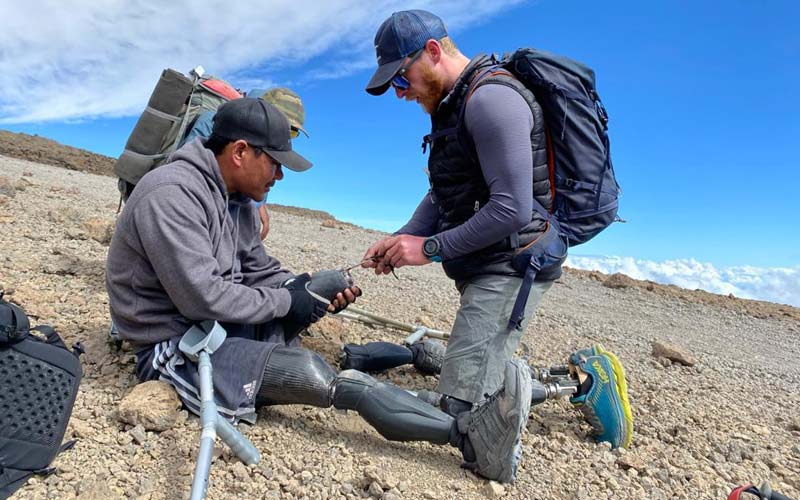
Justin And Hari
Preparation was similar; I just increased the volume of my training. More 10km walks throughout the weeks leading up to the climb, combined with my usual strength and conditioning programme was enough to get me to the top and back down.
Mt Blanc was short and sharp with varying terrain where we were forced to use short prosthetics and gained altitude quickly. Kilimanjaro was long and with favourable terrain for ‘Long Leg’ prosthetic use, but we gained altitude at a much slower rate.
Towards the top of Kilimanjaro, it was a real struggle to stay awake. I was having a lot of what can only be described as out of body experiences. Looking back, I was probably just falling asleep for very short periods of time between taking steps. I enjoy being in this condition as I know I am pushing hard to achieve my goal. I have always thrived off of working to my capacity and beyond, and this reminds me of my time in the army, of which I have fond memories.
We kept the same team, apart from Stephen, he didn’t come on this one as he was planning an ascent of the Matterhorn not long after.
- Is climbing massive mountains the new 'normal' for you, or is it still a surprise to be doing it?
This is a great question. It’s certainly not the norm to see someone with my condition summitting these mountains, and I absolutely love seeing the reactions on other climber’s faces when they see me on the hill. I’m not sure it’ll ever be normal for me either.
It’s so difficult to articulate just how demanding these climbs are, but I’m only just getting started. I love the raw environment of the mountains and the lessons they teach me and I hope the feelings of elation, when climbing, never leave me.
- Having completed a successful summit of Mt Kilimanjaro, which mountain is next on your list and what are your goals for the rest of 2020 and the coming year?
Well, before the pandemic, we had planned, again, alongside HST adventures, to go and attempt Mt. Elbrus, Russia. In fact, that was scheduled for July 2020. We are now looking to get this re-booked for summer 2021. But, there is a possible trip to Nepal to climb the 7000m peak Himlung, at the end of 2020. We’ll see!
Q: And finally, having read some of your ‘Field Notes’ on your website you finish one of them with the sentence:
“ BE more, DO more, GIVE more. ACHIEVE.”
Could you summarise what this message means for you and how others can try to adopt this positive outlook and put it into action?
Absolutely! This just popped into my awareness one day after a hard climb/hike. I was in pain, and my whole body was aching, but I was super happy with my efforts, and the phrase was coined then and there.
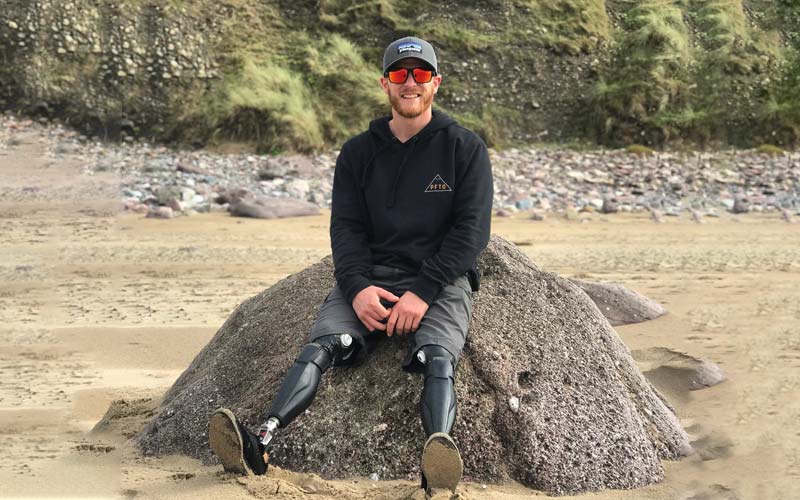
BE more, DO more, GIVE more. ACHIEVE.
It is really meant to empower those who read it; to raise awareness within oneself that their time on this planet is limited, and we have SO much potential as humans, and as individuals. If we come together as a team, we can achieve anything. I guess it's really just to encourage positive thoughts, movement and growth through physical challenge.
Thanks again for your time Justin, we wish you the best of luck with your future endeavours and look forward to seeing you at the top of many more mountains.
Thanks, guys! It’s a pleasure to be invited to share my journey. I sincerely hope your readers can take something away from my hardships, and I look forward to seeing you all on the hills in the not-too-distant future!
If you also want to join us in supporting Justin on his journey to conquer the Seven Summits you can follow him on his Instagram, Facebook page or discover more about him on his website.

